Biography
Interests
Arnold Dzeken Silenou1, Fabrice Tonfack Djikeng1*, Gires Teboukeu Boungo2, Morfor Theresia Azia1, Blaise Arnaud Hako Touko1 & Hilaire Macaire Womeni2
1School of Agriculture and Natural Resources, Catholic University Institute of Buea, P.O BOX 563, Buea, Cameroon
2Department of Biochemistry, Faculty of Science, University of Dschang, P.O BOX 67, Dschang, Cameroon
*Correspondence to: Dr. Fabrice Tonfack Djikeng, School of Agriculture and Natural Resources, Catholic University Institute of Buea, P.O BOX 563, Buea, Cameroon.
Copyright © 2018 Dr. Fabrice Tonfack Djikeng, et al. This is an open access article distributed under the Creative Commons Attribution License, which permits unrestricted use, distribution, and reproduction in any medium, provided the original work is properly cited.
Abstract
This study was conducted in order to evaluate the effect of cooking time on the phenolic content and antioxidant activity of some vegetable: Carrots (Daucuscarota), Green beans (Phaseolus vulgaris) and Green pepper (Capsicum annuum). The plant materials were each divided into four respective groups amongst which the first was boiled for 5 min, the second for 10 min, the third for 15 min and the fourth served as control (0 min). After all treatments, the vegetables were dried in the oven and used for the extraction of phenolic compounds and evaluation of the antioxidant activity. Results showed that boiling time significantly decrease (p<0.05) the polyphenol content and the antioxidant activity of these vegetables. These vegetable should be eaten raw or cooked for a maximum duration of 5 min.
Introduction
Natural antioxidants such as phenolic compounds, vitamin C and others are widely distributed in foods and vegetables. Many works have indicated that frequent consumption of foods rich in phenolic antioxidants such as fruits, vegetables, herbs, spices etc are associated in the reduction of the prevalence of cardiovascular diseases, neuro-degenative diseases, cancers, aging… [1]. The beneficial role of natural antioxidants such as phenolic compounds, vitamin C and E has been attributed to their good antioxidant activity and protective effect against degenerative diseases [2]. Many of these antioxidants are also found in vegetables such as carrots, green beans and green pepper, which are significantly produced and consumed in Cameroon. They are generally and used in the preparation of foods, and the famous processing method used is boiling. Vegetables processing such as boiling, blanching, microwaving, steaming and freezing are expected to affect the composition and availability of natural antioxidants [3]. During processing, the amount natural antioxidants such as heat labile phenolic compounds and vitamin C can significantly decrease, leading to a reduction of their antioxidant power [4]. The decrease in phenolic compounds in plant materials generally leads to a significant reduction of their protective action on humans, thus exposing them to several freeradicals- related disorders. Many studies have reported the effect of processing on the phenolic content and antioxidant activity of vegetables [2,5]. Zhang and Hamauzu (2004) demonstrated that cooking affect the antioxidant component and antioxidant activity of Broccoli [6]. Ismail et al. (2004) also showed that thermal treatments reduce the total phenolic content in all vegetables [7]. Though considerable attention had been given to the study of the effect of cooking on the phenolic content and antioxidant activity of vegetables, very few have been reported on the effect of cooking time on the phenolic content and antioxidant activity of vegetables produced and consumed in Cameroon, such as carrots, green pepper and green beans. Boiling time can significantly reduce the phenolic content and antioxidant activity of vegetables, thus reducing their protective effect against diseases due to oxidative stress.
The objective of this study is to evaluate the effect of boiling time on the phenolic content and antioxidant activity of three vegetables (Carrots, Green pepper and Green beans) produced and consumed in Cameroon.
Materials and Methods
Fresh Carrots, Green beans and Green pepper (Daucuscarota, Phaseolus vulgaris, Capsicum annuum)
respectively were purchased from Muea local market, South-West Region, Cameroon in December 2017.
All chemicals and reagents used were of analytical reagent grade.
Carrots, Green bean and Green pepper were cleaned and divided into 4 groups of 500g each. Carrot, Green
beans and Green pepper were respectively divided into 04 groups, which were respectively boiled in 1L
of water at 98°C for 5, 10 and 15 min. The last groups for each vegetable was not processed and served as
control.
It is important to note that the vegetables were not in direct contact with water during cooking. After this, all the above mentioned samples were dried in an electric oven for 48h at 50°C before being used for further analysis.
Dried vegetables samples were grounded using a grinding machine (Moulinex). 20g of each sample power
was extracted with 400ml of methanol for 48h at room temperature. The mixture was regularly subjected
to shaking during the extraction. The extract was filtered with a Whatman No. 1 filter paper, and residue
was again extracted with 200ml of methanol to ensure maximum extraction of phenolic compounds. The
combined filtrates were subjected to rotary evaporation at 40°C under reduced pressure for the removal of
the solvent. The dried extract was used for the determination of the total phenolic content and antioxidant
activity.
The radical scavenging activity of each extract was determined using the 2,2-diphenyl-1-picryl hydrazyl (DPPH) method, as described by Womeni et al. (2016) [9]. A total of 4.5ml of 0.002% alcoholic solution of 2,2-diphenyl-1-picryl hydrazyl (DPPH) was added to 0.5ml of different concentrations (250, 500, 1000, and 2000μg/ml) of samples and standard solutions separately, in order to have final concentrations of products of 25-200μg/ml. The samples were kept at room temperature in the dark and after 30 min and the absorbance of the resulting solution was measured at 517nm. The absorbance of the samples, control, and blank was measured in comparison with methanol. The antioxidant activity (AA) was calculated according to the formula:
AA = Antioxidant activity, Abscontrol = Absorbance of the DPPH solution, Abs= Absorbance of the sample
The antioxidant potential of carrot, green pepper and beans extracts was also evaluated by their ability to reduce iron (III) to iron (II) following the method of Oyaizu (1986). An aliquot of 0.5mL plant extract
(250, 500, 1000, and 2000μg/mL) was mixed with 1mL phosphate buffer (0.2M, pH 6.6) and 1mL of
1% aqueous K3Fe (CN)6 solution, well shaken and incubated at 50°C for 30 min. After incubation, 1mL of
10% TCA solution was added to stop the reaction and the mixture was centrifuged at 1008g for 10 min. 1.5mL of supernatant, 1.5mL of distilled water and 0.1mL of 0.1% FeCl3 solution were mixed and incubated
for 10 min and absorbance read at 700nm on spectrophotometer.
The final concentration of the extract solutions were of 12.5-200μg/mL. A sample blank, containing all the reagents but no extract was prepared in the same conditions. A higher absorbance indicates a higher reducing power.
Results (Mean±Standard deviation) obtained in the present study were subjected to one-way analysis of
variance (ANOVA) with Student-Newman- Keuls test using Graphpad-InStat version 3.05, to evaluate
the statistical significance of the data. A probability value at p<0.05 was considered statistically significant.
Results and Discussion
The change in total phenolic content of Carrots, Green pepper and Green beans during processing is
presented in Figure 1. A significant decrease (p<0.05) in phenolic content was registered in all the samples
compared to their respective controls. The highest phenolic content was recorded in Green pepper followed
by the Green beans while the lowest one was registered with Carrots.
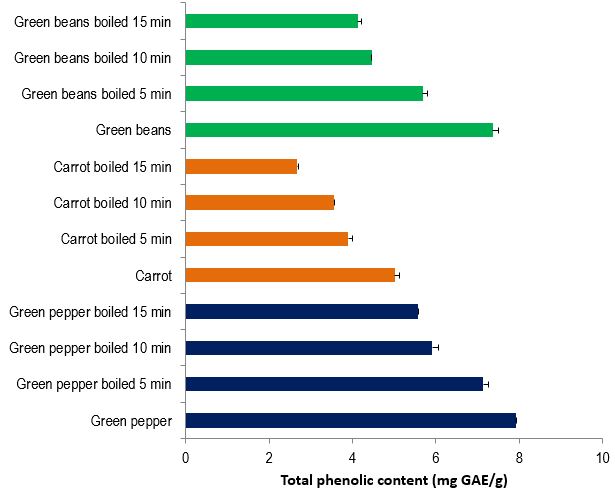
Values are presented as Mean±SD. (a-d)Values with different superscripts are significantly different (p<0.05)
The changes in radical scavenging activity of carrots, Green pepper and Green beans are presented in figure
2 (A-C). Generally as previously observed with the total phenolic content the radical scavenging activity
of these vegetables was significantly deceasing (p<0.05) with boiling time and this at all concentrations.
Compared to the other extracts Carrots extracts have exhibited significantly lower DPPH radical scavenging
activity. Its antioxidant activity varied from 4-14%, while that of Green beans and Green pepper was
respectively ranged between 5-55% and 10-50%. However the activity of all these extracts was increasing
with the concentration.
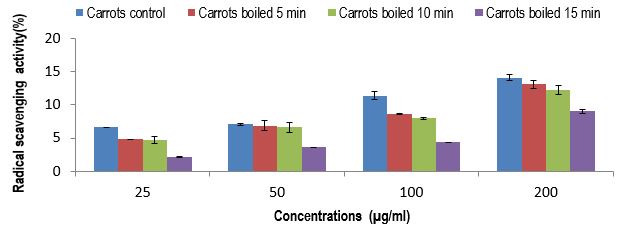
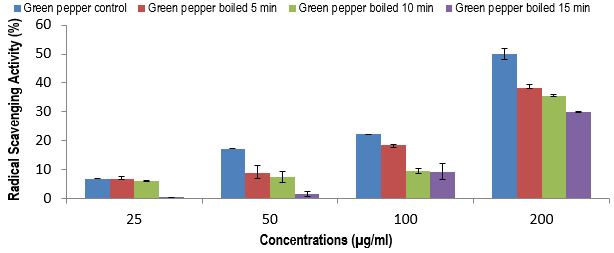
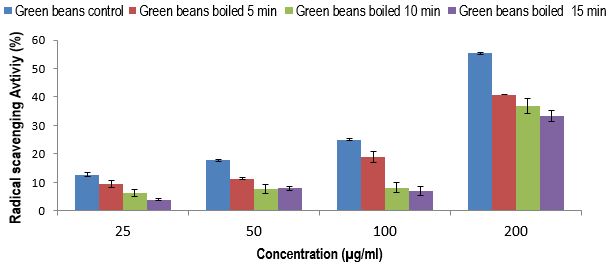
Values are presented as Mean±SD. (a-d) Values with different superscripts at the same concentration are significantly different (p<0.05)
The variation in the ferric reducing antioxidant power of carrots, green pepper and green beans are presented
in figure 3 (A-C).A significant decrease (p<0.05) in antioxidant activity with boiling time was registered
in all the samples and at each concentration compared to their respective controls. The ferric reducing
antioxidant power of all the sample was increasing with their concentration the highest was recorded with
Green pepper (0.15-0.59) followed by Green beans (0.22-0.6). The lowest activity was registered with Carrot
extract (0.01-0.22).
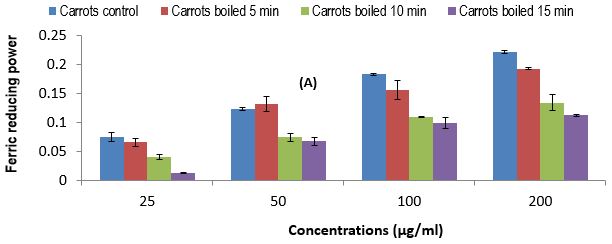
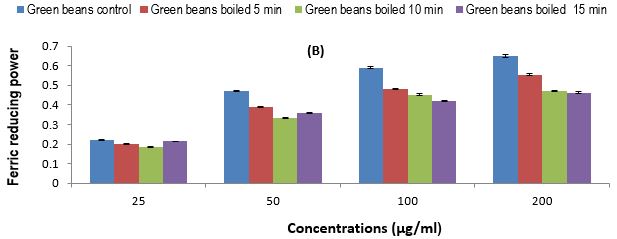
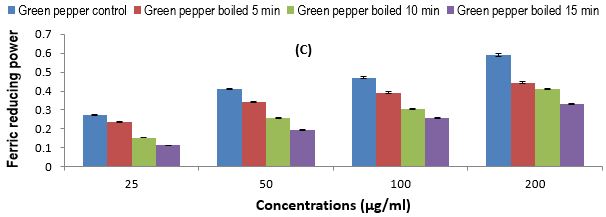
Values are presented as Mean±SD. (a-d) Values with different superscripts at the same concentration are significantly different (p<0.05)
The evaluation of the total phenolic content of carrots, green pepper and green beans showed that, this
parameter significantly decrease (P<0.05) with boiling time and that green pepper had the highest phenolic
content followed by green beans. The fact that the total phenolic content of vegetable decrease during
processing has already been reported. Preti et al. (2017) have demonstrated that the total phenolic content
of green beans significantly decrease after cooking by steaming and boiling [10].
In the same line Turkmen et al. (2005) showed that the phenolic content of some vegetables such as peas and leek significantly decrease after boiling, steaming and microwaving [5]. On the other hand, Shotorbani et al. (2012) showed that the phenolic content of sweet pepper also known as green pepper was decreasing with incubation time at high temperature [11]. These observations are in agreement with the results obtained in this study. However, in some reports it has been demonstrated that such treatments lead to an increase of the total phenolic content of some vegetables such as spinach, broccoli and pepper [5]. The reduction in total phenolic content observed in all the vegetables with boiling time can be attributed to the breakdown of these compounds during cooking at high temperature [12]. This process can be increased by the fact that prior to cooking the vegetables were cut to remove the unedible parts. Cutting operations have been reported to reduce the polyphenol concentration due to oxygen exposure and the activation of polyphenol oxidase [13,14].
The evaluation of the antioxidant activity of carrots, green pepper and green beans showed that their activity is proportional to their concentration, and significantly decrease (p<0.05) with boiling time. The decrease in antioxidant activity of vegetable during processing is in correlation with the decrease in total phenolic content previously registered. In fact phenolic antioxidants are large class of plant secondary metabolite that have been proven to be responsible of their good antioxidant activity. Generally, plants with a high total phenolic content also exhibit high antioxidant activity [15,16]. The decrease in antioxidant activity of carrots, green pepper and green beans with boiling time observed in this study is in agreement with the results reported by Preti et al. (2017) who showed that the DPPH Radical Scavenging Activity of purple, green and yellow beans was significantly decreasing after boiling and steaming [10]. However, these results are not in accordance with those reported by Bembem and Sadana (2014) and Turkmen et al. (2005) who showed that the antioxidant activity of pepper, squash, green beans, broccoli, spinach and carrots was increasing with boiling and steaming [17,5]. The cooking techniques and conditions might be responsible for the changes observed. In order to benefit from the phenolic antioxidants present in these vegetables short cooking time (5 min) is preferable.
Conclusion
The objective of this study was to evaluate the effect of cooking by steaming on the phenolic content and
antioxidant activity of carrots, green beans and green pepper. Results showed that the total phenolic content
and antioxidant activity of these vegetables significantly decrease with boiling time. Overcooking these
vegetables is not suitable as it leads to the loss of natural phenolic antioxidants which can help in reducing
the prevalence to diseases related to oxidative stress. These vegetables should not be cooked for more than
five minutes by steaming.
Conflict of Interest
Authors have declared that no competing interests exist.
Bibliography

Hi!
We're here to answer your questions!
Send us a message via Whatsapp, and we'll reply the moment we're available!